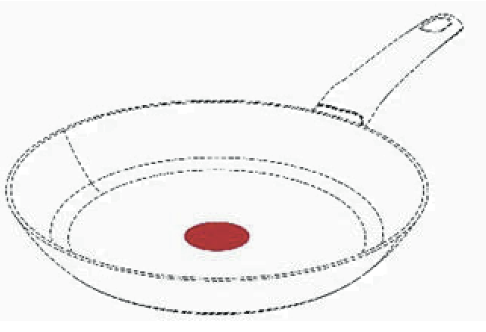Tefal’s pan with the “famous red spot”: proving an indicator of commercial origin
Tefal applied to register the mark (shown below) in the UK for frying pans and related goods in class 21. The application was rejected as being devoid of distinctive character. Tefal submitted evidence of acquired distinctiveness, including a survey.

Tefal had sold over 42 million units since 2000 and net sales were over EUR 340 million. It had spent over £20 million in UK promotion over the last ten years, including displaying the famous red spot in major publications such as Good Housekeeping and The Times. Products bearing the mark had featured in commercials aired during popular shows such as MasterChef (4 million viewers in 2013). A witness statement from the COO of the British Home Enhancement Trading Association confirmed that a round, red spot at the centre of a frying pan was known in the industry and understood as an indication that the product originates from Tefal.
Despite such substantial sales over a significant period of time, the issue essentially came down to whether the red dot, on its own, would be seen as an indicator of brand origin by consumers.
Of 400 people interviewed across the UK in May 2019, the survey had shown that 32.5% mentioned “TEFAL” unprompted when asked what came to mind when they saw the mark. A further 27.75% mentioned “TEFAL” when prompted to name a company. Ultimately the survey showed that 60.25% of respondents mentioned Tefal in their responses, a statistically significant proportion, especially in the context of a crowded market.
However, simple exposure and recognition of a sign does not make out the case for acquired distinctiveness. The hearing officer believed a perfectly legitimate question to pose was what measure, if any, of trust or confidence the applicant had placed in its sign, such as to educate the public that it was a guarantee of origin? The hearing officer struggled to see exactly how Tefal had shown such confidence in the mark. The sort of confidence in question is not necessarily independent use of the sign but, for example, a referencing of the red spot in some way (such as, “The pan with the red spot”), other than as a simple feature.
The Kit-Kat case (Societe Des Produits Nestlé SA v Cadbury UK Ltd [2017] EWCA Civ 358) was of particular relevance, since it introduced the question of reliance as opposed to association. The hearing officer was not convinced that the evidence demonstrated that the red spot alone would be seen as an indicator of brand origin as opposed to associating the mark with Tefal. Nothing in the evidence specifically drew attention to the red spot as being a badge of origin in itself. The survey also seemed to show simply recognition of and association with a major player in the cookware sector, rather than the kind of material perception as a trade mark, which the case law required (see, for example, Jaguar Land Rover Ltd v Ineos Holdings Ltd [2020] EWHC 2130 (Ch)).
The hearing officer also had grave concerns that the applicant’s sign was an indicator of heat rather than an arbitrary or random red spot operating as a guarantee of origin. Some of Tefal’s own evidence noted this THERMO-SPOT innovation, a heat indicator that changed appearance depending on the temperature of the pan. The evidence also disclosed references to that technology in the Grattan, Tesco and Argos catalogues; as well as no fewer than 65 of the 400 survey respondents who indicated that the sign showed a heat spot. These figures critically undermined Tefal’s claim that the mark was a “famous red spot”. The hearing officer held that the mark, in the eyes of many, could not be divorced from its technical function. Indeed, the hearing officer was of the opinion that Tefal’s evidence had been carefully curated to seek to draw his attention away from the mark’s technical function.
In short
Proving acquired distinctiveness can be a challenging task, even for well-known marks that are recognized by consumers. Brand owners should ensure that any evidence of acquired distinctiveness focuses on how such consumers rely on their mark as an indicator of commercial origin, rather then simply associating it with them.

